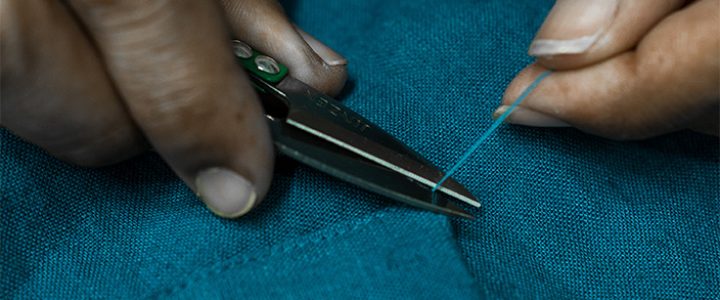
Home / Thread Count Guide: How to Choose the Best Thread Count For Sheets

Thread count is not as complicated as it sounds. It is basically the number of threads woven into your sheets that plays a big role in how comfy your bed feels. We are here with a thread count guide for sheets to break it down for you so that you can make choices that suit your needs.
So, if you’ve ever wondered why some sheets feel super comfortable and others not so much, join us in this bedding sheet thread count guide.
In simple language, thread count is the number of threads woven together in a square inch of fabric. These fine details determine how soft and durable your bed sheets will be.
Now, how is it calculated? It is pretty simple – count the horizontal (weft) and vertical (warp) threads in one square inch. The total gives you the thread count. Easy, right?
Why does it matter? Well, thread count is important because it tells you about the density of your sheets. More thread often means a smoother and more luxurious feel. But here is the catch: it is not the only factor that will decide how comfortable your sheets are.
Ever run your hand over high-thread-count sheets? It’s like a gentle caress. The right bed sheets and thread count can transform your bed into a cloud of softness, inviting you to unwind after a long day.
Your sheets need to breathe, just like you do. The right thread count for sheets ensures that air circulates well, keeping you cool and comfortable, especially on warm nights.
Close your eyes and imagine sliding into bed after a tiring day. The right thread count for sheets makes this experience heavenly. It’s not just about softness but about creating a personalised experience.
These sheets are often more porous and perfect for warm climates. They might not have the same silky feel as higher thread counts, but they bring a relaxed, casual charm like you see in linen bedding.
Conversely, mid to lower thread counts can offer a different quality. Sheets in this range tend to be more breathable, durable and budget-friendly.
High thread count sheets are often associated with a silky, smooth touch. They can feel indulgent and lavish, creating a hotel-like experience right at home. However, they might trap more heat, so consider your climate.
Sheet quality is your personal preference. It essentially means knowing the thread count that aligns with your needs and requirements. Whether you opt for the richness of a high thread count or the easy comfort of a lower count, the key is finding the balance that makes your bed a personalised abode.
Read More: Cotton vs. Linen Sheets: What’s Perfect Bedding Set for Room?
Contrary to popular belief, an astronomically high thread count doesn’t always translate to superior quality. While it can offer you a luxurious feel, it’s not the sole indicator of sheet excellence. It is recommended to find the right balance. Extremely high thread counts might provide a smoother touch but could compromise durability. You must discover the sweet spot that aligns with your comfort expectations and practical needs to get a good thread count for sheets.
There’s no perfect answer to what’s the best thread count for sheets.
But let us help you understand the concept of the best thread count for sheets. When looking to buy a new pair, you need to begin by considering your individual preferences:
Read More: Why Expensive and Luxury Bedding Truly Worth the Investment?
Now, let us explore the relationship between a good thread count and sheet quality. What is a good thread count? In certain scenarios, a higher thread count truly shines. If you crave a hotel-like experience or are preparing for a special occasion, higher thread counts (400 and above) can upgrade your bedding game. They offer you a regal and luxurious feel.
So, is a higher thread count better for sheets? For everyday comfort and durability, a balanced approach in the mid-range thread count (200-400) often proves to be ideal. It offers you a cosy feel without compromising the sheet’s lifespan.
There are specific scenarios where thread count becomes a backbone in enhancing your overall experience. There are times when you feel like having soft-spoken luxury. This is where the sheets with a higher thread count (400 and above) take the spotlight. They craft an exquisite, almost pampering touch that transforms your bed into a serene place. Conversely, when practical considerations are at the forefront, such as in climates where breathability is essential, a mid-range thread count (200-400) becomes crucial. It makes sure your sheets remain cool and comfortable, striking the right balance between luxury and functionality.
Read More: How to Pick the Best Organic Bedding and Features to Look For
In instances where durability is non-negotiable, a mid-range thread count proves resilient to wear and tear, ensuring your sheets remain a long-lasting staple. For the environmentally conscious, sustainable material choices might outweigh the allure of a higher thread count. Factors like organic cotton or linen contribute to a satisfying and environmentally friendly product, urging you to consider the quality beyond mere thread count.
Your comfort should be the foundation of your selection of bedding sheets. It should be about finding sheets that not only flaunt a desired thread count but also cocoon you in relaxation and tranquillity. The intricate weave is also an important factor that you should consider. The final products you see are skilfully created by dedicated artisans who infuse each sheet with diligent attention to detail, elevating the overall quality. Their hard work presents you with a product that stands the test of time.
Material choices also play a crucial role. Whether it’s the permeability of cotton, the sustainable charm of linen, or a thoughtful blend of fabrics, the material becomes a defining factor in creating sheets that are satisfying, durable, and delightful.
Sustainable practices, craftsmanship, and material sourcing are vital elements in shaping a superior bedding experience. Your conscious approach to these elements ensures that your sheets not only feel exquisite but are also crafted with a responsible commitment to the environment.
Different materials have different thread counts. These counts influence the behaviour of the fabrics and their textures. Let’s see what each offers:
| Fabric | Average Thread Count | Major Features |
| Linen | 80 – 150 | Super soft, durable, and lightweight |
| Cotton | 200 – 400 | Soft, less durable, but breathable |
| Silk | 400 – 600 | Super soft, lightweight, and opulent |
| Synthetic Fibres | Varies on fabric | Mostly soft but not very breathable |
In such cases, you should always note that a higher thread count does not imply softness. Depending on the texture of the fibre, the ideal thread count varies. In the end, your choice of fabric depends on certain factors like your personal preference, the climate you are in, and your intended use.
With its lower thread count, Linen is nothing less than a celebration of unique qualities beyond mere numerics. Once you understand why linen has fewer threads, you will realise that solely basing your decision on thread count is not justified.
Acknowledge the sustainability aspect woven into the fabric of linen. Respect the contribution of this natural fabric to a comfortable and environmentally conscious bedding choice. The lower side of linen thread count is not a compromise but a deliberate choice that enhances its breathability and durability. Moreover, the natural texture of the flax fibre does not require a higher thread count to offer softness. It is inherently gentle on your skin, along with offering you a multitude of benefits.
Read More: Benefits of Organic Bedding: Are Organic Bed Sheets Worth Investing
The tiny interlocks of warps and wefts in a fabric serve more than just functionality. They offer you comfort, softness, and, most importantly, warmth. In the concept of bedding, even though these numbers hold immense importance, they are mere numbers.
Your focus should be on creating a haven of cosiness with ultra-soft sheets. Research properly and understand what each material has to offer to you. Once you have all the facts, pick the most suitable sheet for you, irrespective of its thread count.

Experience the artisanal love and redefined luxury that curates a homely feeling. A heavenly touch of our linens will create endless memories